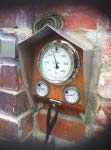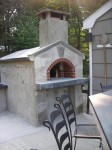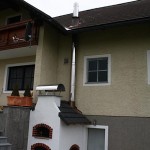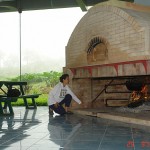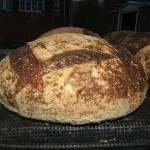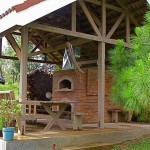back to board Main Page
cement
From the WFO board
Posted by Rado on August 31, 2004 at 15:51:18:
In Reply to: cement posted by Rob on August 30, 2004 at 15:31:24:
Rob, thanks for posting. The print is from one interesting person who brought it for me when we were making his template.
You can place from none up to 3 or 4 firebricks laying on each other to make the wall; and making template into proper vault/ceiling measurement. Have a look at pictures of 'Masterly oven' in it's page, the wall is two firebricks high and template adjusted for the vault size. (Vault = internal height between floor and highest ceiling point) I prefer not to stand up bricks and of course not to use mortar at all where ever possible, it's not needed. When you use mortar in other parts of the dome use only a thin amount. In places where there is a bigger gap fill it with firebrick pieces mortared in between.
In regards to the refractory cement(s), top mortar is 1 part clay and 1 part sand. That's the TOP quality refractory. Like firebricks, made of the same stuff and in the manufacturing process they are fired in industrial kilns. If you can support both sides well when you create arches for the dome you do not need to use cement which assists quicker setting. Lime is in fact calcium taking over cements in heat, many years ago master oven builders used it and they didn't hear about calcium Aluminate cements. There is not refractory cement in a firebrick body and a standard 26% alumina content firebrick is meant to withstand 1320deg.Celsius continuous use ;o), color chart would show you yellow to white hot- that's after red hot. Such temperature can not be reached in wood fired ovens. More important is the heat expansion or shrinkage and this means temperature differences in material body...
Use the mix for cladding as in the CD. I get so many emails people asking what to use instead of firebricks, refractory cements, vermiculite for insulation or fireclay because it's not available locally. I am not surprised; industries use these mainly for high heat furnace applications in castables etc. All so expensive too. Cheaper materials are around with even better properties for wood fired ovens. I am about to add all of these substitute materials in the building CDrom. 'Masterly oven dome' design comes later I need some time to fit it on one CD it's on 2 Cd's at present (or 1 DVD instead of 2 Cd's.)
EDIT: there are now 3 wood fired oven designs/plans being sent out to oven builders.
It's all in the website here. Heaps of people email me straight away without a sign they bothered to absorb/learn any information, and so then I write and write. Thoughts like where do you put the pizza and then how can we get your CD. I come from non English speaking background so at least I become better writer. If you do not practice writing you won't write well. If people who can't put effort into research just by reading what can they build. But many like you put good thoughts into it so thanks a bunch for your time.

Jamie and Katrina's brick oven with temperature gauge, in Victoria.
Concrete blocks used for the oven’s outer walls. By Joe in Connecticut USA
Wood fired family oven and chimney project by Robert in Austria
My oven with fireplace, cook food and heat water, by Joel in Philippines
Baking sourdough breads in quantity in Canada
Pizza oven and hut built by Tony in Philippines
